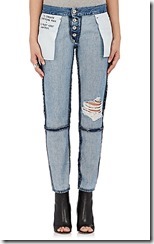When I was growing up, menstruation was a pretty hush-hush deal. Mothers closed the bathroom door and whispered the icky info to their daughters. Out came the box of pads and the belt, and a just-in-time demonstration of how it was all supposed to work. I recall howling madly about how unfair it was when my mother took my older sister in for “the talk” and didn’t include me. So,naturally, when Kath got her period I unwrapped one of those used pads swathed in toilet paper to see what was up. I couldn’t quite piece it all together, but I did cannily figure out it had something to do with blood.
Anyway, I got my turn, and like my sister Kath and millions of girls before us, I’d been prepped by reading “Growing Up and Liking It,” which was put out by one of the sanitary napkin “Big Two” – either Kotex or Modess.
By the time it came into my greedy little hands, the pictures of the girls in it already seemed out of date. They were from the 50’s, not the 60’s. Not that the cross-cut of the uterus changed between the 50’s and 60’s, but it was really difficult to take the book seriously given how old-timey those pony-tailed, pedal-pushered girls looked to me.
But at least “Growing Up and Liking It” had concrete info and facts. Unlike the ads for Modess and Kotex, which barely mentioned just what unmentionable they were for.
The ads – magazine, only, thank you; it was okay to advertise beer, cigarettes, and Preparation-H on TV, but nary a mention of sanitary napkins or tampons – pictured beautiful ladies in beautiful chiffon ball gowns. Modess…Because. Because what, exactly? Who cared? We cut those pictures out and put them in our scrapbooks. Why not? Those scrapbooks were full of actresses we’d never heard of. I remember clipping a picture of Terry Moore out. Who the hell was Terry Moore? As long as it said ‘movie star’…And as long as the ladies were beautiful.
Back to periods: among the hush-hush-ness in my house was my mother’s telling me not to discuss periods with my friends.
Well, that didn’t last long.
I remember being out in the backyard, on a nice summer day, under the big tree in the corner, lolling about on one of my father’s old Navy blankets with my friends Bernadette and Susan, talking about our periods. Which we were all having. Which meant that, by the time eighth grade started, we “got” the joke that Patty G – a somewhat racier and more advanced classmate – whispered to us in the schoolyard at recess. (“Not for mixed company,” she began, and then launched into a “dirty joke” that had to do with using paint to show your boyfriend that you were having your period and couldn’t have sex. Green paint, the punch line went, meant that your period “wasn’t ripe.”)
Having your period did, of course, involve a ton of embarrassment. Periods were messy. Everyone I know had at least one “accident” experience. One of mine was the pad coming unhooked and dangling while I was playing kickball – in mixed company, no less – when the smart kids who took after-school Spanish took our break before Senor Ramirez showed up for class. I ducked into the priests’ garage and hooked it back up, but it wasn’t all that wonderful to have been running the bases with my Kotex pad flapping.
Buying sanitary supplies was also an embarrassment. When I was in early high school, I needed to buy some. How, in a home with three females regularly “on the rag”, as we used to say, we ran out, I’ll never know. But my other asked my father to drive me to the drugstore to stock up. Driving to the drugstore – a 5 minute walk if that – was a hoot to begin with, especially given that my father didn’t have a lazy bone in his body. But there we were, in the parking lot of Sol’s Maincrest Pharmacy, me telling my father that he had to go in and make the buy. He was a bit pissy about it, but he went in anyway. (Thanks, Dad.)
But certainly by later in high school, I was capable of buying my own sanitary supplies, which somewhere along the line meant tampons, rather than sanitary napkins.
My formative experiences, period-wise, are 50+ years ago. I was certain that there were hipper and more knowing places where modern, cool moms bonded with their daughters over period talk, and where modern, cool girls zipped, breezy-peasy, into the local pharmacy and brazenly bought their own supplies. But, Patty G’s dirty joke aside, Irish Catholic Main South Worcester wasn’t one of them.
Not quite Laura hand-washing cloth pads with Ma Ingalls in the backyard of that little house in the prairie. But still, one would think, a primitive era, comparatively, both attitudinally and equipment-wise.
Fast forward, and a local mother of two girls mom “has started a company selling feminine products by mail order to young women.”
Mail order sounds to me the 21st century equivalent of making my father go into Sol’s to buy Kotex.
Getting your period has been making adolescent girls nervous eons. But Helen Walsh wants to make the first period a moment that’s much more, well, chill.
The Milton-based mother of two daughters is the founder of LoveJane, an online, subscription-based feminine care service, launched last month, that targets adolescent girls with BPA-free products that are sized for growing bodies. (Source: Boston Globe)
There are, apparently, any number of “subscription services” aimed at menstruating women. Because…well, because it’s still apparently embarrassing to have your period. And it’s just too inconvenient to have to hop into CVS every once in a while. And because none of the other services are aimed at newbies.
The site offers several kits — a $30 first-time period kit includes a book, a carrying bag, and a pair of backup underwear. Follow-up monthly boxes of tampons and panty liners cost $15.
I just don’t see the demand. Sure, it gets rid of the embarrassment factor (it’s painful to me that this hasn’t gone the way of the napkin belt), and I guess if you want more upscale wares… but monthly boxes of tampons and panty liners cost a lot less than $15 at CVS.
Walsh hopes her service has an edge in that it targets the parents of young women at the beginning of their periods, when they start developing loyalty to one brand.
That tracks with a recent research report on the tampon industry from Global Industry Analysts, Inc. “Mothers usually introduce a specific brand preferred by them to their daughters,” the report reads. “If the daughter finds the product satisfying her requirement, she is least likely to shift brand.”
Tell me about reluctance to shift brands. Scott toilet paper. Hellman’s mayo. But I didn’t stay loyal to my mother’s sanitary pad choice. I switched to tampons.
But, hey, everyone loves a good disruption story. Innovation ‘r us, the rise of the subscription service for all sorts of stuff and all that. (Forget the Book of the Month Club, or the Fruit of the Month Club: you can get just about anything on a subscription basis.) And, given that, once you rope someone in, you’ve got them for 40 years or so, 12 times a year, well…Go for it, Helen Walsh.
And Helen Walsh isn’t the only one trying to make the latest generation of girls grow up liking it. When I googled for this article – I’d seen it, but hadn’t pulled it into Pink Slip yet – I found a story about two Rhode Island School of Design grads who’d invented a board game, The Period Game. (Motto: Let’s flow.)
According to their website, the game “strives to turn a typically uneasy situation into a fun, positive, learning experience” and aims to “teach participants about what is happening within the female body and how to ‘go with the flow.’ ”
“Every turn begins with a player turning one of the two ovaries, releasing a marble into the tray below. A red marble came out? Congrats! You got your period. A clear marble? Better luck next time.” 
With game pieces shaped like tampons and sanitary pads, and playing cards with phrases like “oops . . . you leaked,” we’ve never seen anything else like it. (Source: Boston Globe)
Okay. A subscription service for tampons is one thing, but The Period Game? I’m guessing non-starter.
I grew up liking board games, and, when we weren’t talking about our periods, Susan, Bernadette and I were out there on that Navy blanket playing Clue or Parcheesi. We may have been embarrassed about buying Kotex, but I can pretty much guarantee that, even though we may have lacked the sophisticated knowingness of Patty G., we would have been rolling around on that Navy blanket, laughing our asses off each time one of us twirled an ovary…
 for a pair of jeans to begin with. (Well, maybe a pair of jeans that would make my jean-wearing body look like it did in my twenties.) But my real problem with these jeans is that they’re ridiculous.
for a pair of jeans to begin with. (Well, maybe a pair of jeans that would make my jean-wearing body look like it did in my twenties.) But my real problem with these jeans is that they’re ridiculous. definitely not the audience for a pair of $1,075 Off-white c/o Virgil Abloh’s distressed boyfriend jeans.
definitely not the audience for a pair of $1,075 Off-white c/o Virgil Abloh’s distressed boyfriend jeans. 






